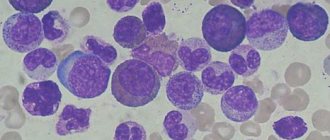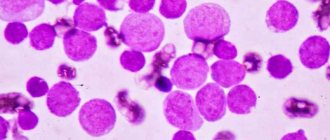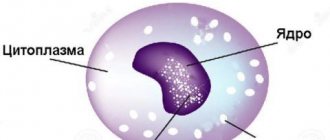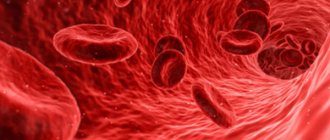Leukemia is a malignant neoplasm that develops in the white bone marrow and affects the hematopoietic function of the organ. The bone marrow itself is responsible for the production of blood cells: red blood cells, platelets and white blood cells.
When affected by a tumor, immature mutated leukocytes begin to be produced in the blood, which constantly divide and completely fill the space, interfering with healthy cells. Also, mutated leukocytes do not perform their protective function.
Additionally, there are several times fewer platelets in the blood, which are responsible for blood clotting, and the number of red blood cells, which carry oxygen to the body’s tissues, decreases.
Immature white blood cells begin to accumulate in the lymphatic system, causing the lymph nodes to become swollen and painful. There may also be damage to healthy organ tissue, which causes a serious complication. The bleeding does not stop for a long time and in the final stages there is a risk of dying from bleeding. Anemia appears as hemoglobin in the blood decreases.
In common parlance, this disease is also called leukemia, but there is also a second official name, leukemia. It is often called blood cancer, although it is not. Cancer is formed from epithelial cells, and leukemia from hematopoietic cells of the bone marrow. Let's still try to answer the question - is leukemia curable or not?
How long can you live
In patients with leukemia, the life prognosis for each person is individual - on average from 5 to 10 years.
Remission may last longer. It depends on the type of blood cancer, its stage, and a positive response to treatment. Approximately 40% of adults are cured. There are several factors that determine the life prognosis for leukemia.
- Age. Elderly people have reduced immunity, so the life expectancy of such a patient is short. The chances of stable remission and even recovery are high in children and young people.
- Stages of development. First (A): people live 10 years or more; the composition of the blood is little changed; You can achieve a full recovery by consulting a doctor in time. Second (B): those affected can live from 5 to 8 years; cancer cells multiply in the blood; taking therapeutic measures guarantees 70-80% survival rate. The third (C) is comparable to the fourth level of development of cancer pathology, when the entire body is affected by metastases; survival period is 1-3 years.
- Chronic or acute form of the disease. With chronic leukemia, the patient's life span is much longer, since the presence of mature and immature cells slows down the development of the disease. Acute leukemia progresses quickly and is difficult to treat. Blood cancer differs in that both of these forms are independent diseases and do not flow into one another.
In acute form
This type of leukemia, if left untreated, will lead to death within a few months. Blasts (immature cells) multiply rapidly. After laboratory tests, the last stage of leukemia is diagnosed. Treatment is virtually ineffective, especially for those over 70.
The chances increase if the type of leukemia is lymphoblastic and treatment is started in a timely manner. Between 80% and 90% of patients recover. If the type of leukemia is myeloblastic - 40-50%. This is the most severe form of blood cancer.
For acute myeloblastic blood damage
Characteristic of this form of leukemia is the process of formation of myeloblasts in the spinal cord, which are unhealthy for the entire body. In the bone marrow, the myeloid lineage that generates leukocytes is affected. They actively multiply in the circulatory system. These malignant cells suppress the formation of healthy ones, resulting in the entire body becoming infected. The main symptoms are fever above normal and pain in the bones.
Myeloblastic blood lesions most often affect children. Timely treatment allows you to achieve remission. The likelihood of healing is low if the blood pathology is advanced. With a stem cell transplant, hope for recovery increases.
In chronic form
Chronic leukemia progresses slowly, since not only blasts, but also mature cells are present in the bloodstream.
With chronic leukemia, a patient can live a long time, up to 20 years. The survival rate is high - up to 95%. Using modern therapy, it is possible to achieve stable remission, especially in women. In old age, chemotherapy helps 75% of people survive.
Types of disease
Treatment tactics and chances of recovery largely depend on the type of disease. Chronic and acute leukemia are distinguished; this is not related to the rate of leukemia.
- Acute form. Characterized by damage to immature cells. A rare variant of the course of the disease, in which, instead of normally maturing erythrocytes and leukocytes, undifferentiated maternal cells grow.
- Chronic form. It is characterized by slow development, pathological changes in maturing and mature blood cells. It affects older people, and in two percent of cases it is detected in children under twelve years of age.
Both acute and chronic forms develop according to one of two variants of the course, which distinguishes two more types of leukemia.
- Lymphoblastic leukemia. This is a tumor that arises from the precursors of lymphoblast cells. At first it is located in the red bone marrow, then metastases spread to the lymph nodes, nervous system and various organs. Most often found among children. It has been noticed that young men and boys suffer from lymphoblastic leukemia more often. Diagnosed at three or four years of age. The peak incidence in adults occurs at retirement age.
- Myeloid leukemia. Characterized by rapid growth of myeloid cells, as a result they accumulate in the peripheral system. A blood test reveals a high level of leukocytes. These are mainly granulocytes. The disease develops regardless of age, but is diagnosed in middle-aged patients.
To understand whether leukemia is curable or not, it is important to take into account some treatment features. Often the outcome depends on the patient himself or the parents, if we are talking about a child.
How long do you live with blood cancer?
Blood cancer arises from a single bone marrow cell that begins to divide constantly and uncontrollably. Specific white bodies develop, which gradually displace and suppress the growth of normal blood cells. It is the lack of healthy hematopoietic bodies in the body that determines how blood cancer manifests itself. With this disease, a specific tumor cannot be seen or touched. It does not exist in the body. Cancer cells circulate in the bloodstream. They seem to “disperse” throughout the patient’s body.
Causes of blood cancer
The bone marrow produces blood cells that perform specific functions in the body. Each of these cells can turn into cancer at any moment and become a carrier of a terrible disease. This process occurs under the influence of numerous factors:
- exposure to ionizing radioactive radiation (not one-time, but systematic, regular, as well as a high level of exposure; at risk are workers of nuclear power plants; those living near radiation waste disposal sites; radiologists; x-ray technicians and other persons located near carriers of radiation radiation);
- heredity (if family members have been diagnosed with leukemia, the risk of blood cancer increases by 30-40%);
- influence on the body of mutagenic and harmful substances (alcohols, chemicals, nicotine, some medicines, paints and varnishes);
- exposure to certain viruses that provoke malignant degeneration of blood cells and bone marrow);
- genetic mutations.
Is cancer transmitted through blood? Definitely not. A healthy body simply will not accept pathogenic blood cells. Even with a transfusion, infection is impossible. This is a fact proven in practice.
Blood cancer disease: forms and stages
The form of the malignant tumor determines how long people live with blood cancer. In the traditional classification, acute and chronic leukemias are distinguished. In acute leukemia, the prognosis is worse: the disease develops rapidly and quickly leads to death. Chronic leukemia is less dangerous for the patient's life: clinical recovery is achieved faster. Transition from one form to another is impossible. These are two separate hematological diseases. Blood counts for cancer do not allow diagnosing one form or another. Therefore, the patient undergoes a biopsy.
Treatment methods for blood cancer depend on the stages of the disease:
Initial stage of leukemia. Characterized by the following features:
- blood composition indicators are only slightly changed;
- There is a general deterioration in health and exacerbation of chronic infections.
The initial form can only be diagnosed retrospectively, after the disease has entered the next phase.
Advanced degree of blood cancer. Pronounced changes in hematopoiesis are observed. After treatment, it may progress to the following stages:
- remission (there are no blast cells in the patient’s blood for five years);
- terminal stage (complete inhibition of the hematopoietic system is diagnosed).
Staging for chronic blood cancer has its own specifics:
- the initial stage occurs without external signs; during studies, an increased number of granular leukocytes is diagnosed (monoclonal phase of leukemia);
- the polyclonal phase is accompanied by the formation of secondary tumors and an increase in the number of blast cells; Complications appear in the form of damage to the lymph nodes, enlargement of the liver and spleen.
The prognosis for chronic leukemia is much better than for acute leukemia. The rapid, aggressive development of acute leukemia leads to the rapid “fading” of patients. In addition, this form of blood cancer is difficult to treat and often leads to the formation of lymphoblastic leukemia (about 85% of cases).
Can acute blood cancer be cured? The probability of complete recovery ranges from 60 to 95%. The prognosis with proper treatment can be favorable. Especially for children.
Treatment of patients with acute myeloblastic leukemia with adequate treatment is possible in 40-50% of cases. If a stem cell transplant is successful, the probability of recovery increases to 60%.
The course of chronic leukemia passes slowly. Until a certain point - the onset of blast crisis. Chronic leukemia actually acquires the features of acute leukemia. The patient's death during this period may occur from complications. Timely treatment allows you to achieve stable remission for many years.
Chronic leukemia
As mentioned above, one of the most important studies is a blood test for leukemia. Thus, thanks to it, it is possible to identify this disease in its early stages (before the first symptoms appear). What will the doctor do at the very beginning? Until symptoms appear, so-called vigilant observation will be carried out. The patient must periodically see a doctor and undergo certain tests. What treatment will be relevant for this form of the disease?
- Controlling the disease and managing symptoms is very important.
- Chemotherapy in this case is a practically useless treatment (it is needed only at the level of preparing the patient for transplantation).
- Stem cell transplantation offers an excellent chance of recovery. However, this procedure is contraindicated for people over 50 years of age.
Treatment methods
Most types of leukemia are commonly treated with chemotherapy, which contains large amounts of drugs that kill the affected cells. Treatment is prescribed to each patient individually. More than 15 different antitumor drugs are used, which prolong the patient's life, when prescribed correctly. The drugs are administered intravenously or into the spinal canal. They affect not only the affected, but also healthy cells and tissues.
The dose is usually very large, making the treatment very difficult for patients to tolerate. Chemotherapy should not be used before signs of the disease appear, as it can worsen the patient’s condition.
With an increase in the number of lymphocytes and lymph nodes, several course drugs are prescribed. With a reduced level of platelets and red blood cells, the tissue of the spleen is destroyed.
To treat some forms of leukemia, it is possible to use hormonal anti-inflammatory drugs - corticosteroids; for others, they are strictly contraindicated.
Treatment with chemotherapy is accompanied by hair loss in the patient, attacks of nausea and vomiting, and the risk of bleeding and infections increases.
To maintain the patient's condition, he is prescribed antiemetic drugs, blood transfusions and treatment of infectious diseases.
If chemotherapy does not bring the desired result, a transplant of one's own or a donor's bone marrow is prescribed. Transplantation is possible until the patient reaches 50 years of age.
When using radiation therapy, cancer cells are destroyed by ionizing radiation. A type of radiation therapy is the injection of a small dose of radioactive phosphorus into the body.
Biological therapies involve the use of drugs that act similarly to substances produced by the body. The complex of drugs consists of monoclonal antibodies, interleukins and interferon.
In a stem cell transplant, monoclonal bodies are introduced to suppress and kill abnormal cells. Using this technique allows you to preserve the human immune system.
Blood transfusion is a supportive measure.
In any case, the attending physician will decide how to treat leukemia after a thorough analysis of all factors.
In case of relapse, as a rule, a second course of treatment is prescribed. In this case, a stem cell transplant will be effective.
Treatment of chronic lymphocytic leukemia
The treatment method depends on the patient’s age, leukocyte level, stage of the disease and its manifestations.
As a rule, at the initial stage, a wait-and-see tactic is used until the characteristic symptoms of the disease appear, including:
- weight loss;
- temperature increase;
- enlarged lymph nodes;
- general weakness.
Chemotherapy is carried out for all types of leukemia
Before such symptoms appear, chemotherapy cannot be carried out, as it can lead to a worsening of the condition. Often treatment is not required for 10 years from the moment the disease is diagnosed, since it progresses slowly, and excessive treatment is even worse than insufficient treatment. Usually, in the preclinical period, constant observations and general strengthening measures are sufficient, including a healthy diet, a rational work schedule, proper rest, and the exclusion of physical procedures and exposure to the sun.
When the level of lymphocytes increases and the lymph nodes become enlarged, chemotherapy using several drugs is prescribed. If platelet and red blood cell counts are low as a result of increased cell destruction, the spleen will need to be removed.
With this form, survival rates vary: many live up to 10 years, but there are also those who die within 2-3 years.
Is blood cancer curable or not?
Treatment of blood cancer in this case is the only hope for survival.
Since chemotherapy is the one and only way to treat cancer, you need to be properly prepared for it. Blood cancer is one of the most complex and serious diseases among people. This is a disease of the bone marrow that spreads throughout the blood, gradually infecting healthy cells.
The difficulty with blood cancer is that the tumor is invisible and cannot be removed. As a rule, cancer occurs in a chronic or acute form. Unfortunately, the acute form is most often incurable, therefore, even chemotherapy does not help.
It is also worth noting the fact that blood cancer is often detected in people who do not have any predisposition factors. Everything can go well and there will be no relapses, the main thing is to believe and remember that cancer is curable.
Treatment of blood cancer with folk remedies
Large doses of such a dropper can kill all infected blood cells and, accordingly, destroy the tumor. Scientists are working on this and are doing everything to make cancer treatment easier and safer.
Unfortunately, to date, no other methods of treating cancer have been developed, since this disease is the most complex and dangerous. It is worth noting that blood cancer cannot be cured using traditional medicine, various healers and other similar methods.
As for the chronic form of all other forms of cancer, they are more benign and not so aggressive. Blood cancer" #8212; is an incorrect term for oncological diseases of the circulatory system and hematopoiesis, but is firmly established among patients.
In the past, leukemia was often called leukemia or leukemia due to the appearance of a large number of immature white blood cells in the blood.
Life after treatment
After recovery, the patient is obliged to monitor his lifestyle and health. He needs a balanced diet and a special diet.
The patient must undergo a timely examination: re-development of leukemia is possible. It is necessary to minimize exposure to direct sunlight and avoid contact with chemicals. The patient should expose himself to less stress and monitor the body's immune system.
Important information: How acute lymphoblastic leukemia is treated in children and its symptoms
Thus, experts do not know the exact reasons for the development of leukemia. The disease is not inherited: people with certain hereditary diseases that can contribute to the development of leukemia are at risk. Modern medicine offers proven methods of treating all forms of leukemia, including chemotherapy and targeted therapy, antibiotics, bone marrow transplantation, etc. Timely diagnosis of the disease and surgical treatment are important.
Symptoms of blood cancer
Early stage of acute leukemia
It is necessary to distinguish the symptoms of leukemia at an early stage from those of a later stage. At the initial stage, the patient is faced with:
Painful sensations in the abdominal cavity, especially in its upper region;
Pain in the joints. which may be accompanied by “ache” in the bones;
Frequent bleeding that is quite difficult to stop;
Forced formation of bruises or blood stains;
A significant increase in the size of not only the liver, but also the lymph nodes;
Constant weakness, lethargy and apathy;
A condition with symptoms resembling fever;
Frequent infectious diseases;
Frequent urge to urinate.
As a rule, this stage of blood cancer is diagnosed after the fact - when moving to a further stage of the disease.
Advanced stage of acute blood cancer
The so-called “advanced stage” is accompanied by symptoms such as:
Nausea, which the patient perceives as sudden attacks of malaise, which from time to time are accompanied by significant dizziness and even vomiting;
Seasickness or motion sickness in any vehicle, even if such signs have never existed before;
Active sweating at night;
Rapid weight loss that occurs for no apparent reason.
After timely treatment, it can develop into the following stages:
Remission (blast type cells do not form in the patient’s blood for several years. We are talking about five to seven years);
Terminal (in this case, absolute inhibition of the hematopoietic system is revealed, in which normal functioning is simply impossible).
Late stage of acute blood cancer
At a late stage, if leukemia is not detected, but the following signs appear, the patient needs the most urgent hospitalization:
Lips and nails become blue;
Modifications at all levels of consciousness or increased anxiety. In this case, fainting states may occur for no reason, and there is also an absence of any reactions to external stimulation;
Painful sensations in the heart area, tightness or significant pressure in the chest, palpitation (forced heartbeat with an irregular rhythm);
Increased body temperature (more than 38 degrees);
Extremely high frequency of contractions of the heart muscle (tachycardia);
Dyspnea is a dysfunction of the respiratory system, which is characterized by difficulty or hoarseness;
Perceptible painful tremors in the abdominal cavity;
Uncontrolled or quite strong flow of blood.
Symptoms of the chronic form
The chronic form of blood cancer is characterized by individual symptoms:
The initial stage passes without externally obvious manifestations; if research is carried out, it becomes possible to detect an increased number of granular type leukocytes (otherwise called the monoclonal phase of blood cancer);
The polyclonal stage is characterized by the formation of secondary tumors and a significant change in the number of blast cells. Also, this stage is characterized by the manifestation of complications in the form of damage to the lymph nodes, a significant change in the size of the liver and spleen.
Found an error in the text? Select it and a few more words, press Ctrl + Enter
Symptoms
The difficulty in identifying leukemia lies in the fact that the patient may not attach any importance to the initial symptoms, mistaking them for a common cold. So, among the first signs of blood cancer are usually observed:
- fatigue and increased weakness;
- slight but regular changes in body temperature;
- a sharp decrease in body weight;
- increased sweating at night;
- frequent headaches;
- decreased immunity and frequent infectious diseases;
- lack of appetite;
- pale skin.
As the disease develops, nonspecific symptoms will be accompanied by additional signs that may alert the patient and become a reason for a visit to the doctor. Some of these alarming symptoms include:
- regular nosebleeds;
- pain in bones and joints;
- the appearance of bruises on the body;
- sudden onset irritability;
- rash on the skin;
- blurred vision;
- difficulty urinating;
- dyspnea;
- swollen lymph nodes;
- poor wound healing.
When the disease reaches late stages, the following symptoms are added:
- an increase in the size of the spleen and liver;
- regular bloating;
- feeling of heaviness in the hypochondrium.
Causes
Now scientists do not name specific reasons that can cause this terrible disease.
Experts name factors that cause a predisposition to it:
- Cancer survivors are predisposed to developing a new disease. It is also worth considering whether any of your relatives had this disease, because the hereditary factor plays a significant role.
- If at birth the child was diagnosed with developmental anomalies and genetic disorders, such as Down syndrome.
- Exposure to radioactive radiation. For example, during examinations, many cases of blood cancer were identified in children from the Chernobyl zone.
- If you have a history of blood diseases of various types.
Doctors very often find blood cancer in people who are not predisposed to it. Thus, anyone can be susceptible to this disease.
Prevention
Since the most dangerous cause of this disease is strong ionizing radiation, people should try to visit such places as little as possible. A place of residence close to constant exposure to such rays is considered especially dangerous. You should also avoid contact with various types of chemicals as much as possible. If the patient has a genetic predisposition to the disease, then it is necessary to undergo examinations as often as possible to exclude the occurrence of this disease or to detect it at an early stage (when a complete cure is still possible).
Is blood cancer curable or not, survival prognosis
Blood cancer is an outdated name for a number of blood diseases. Currently, this type of cancer pathology is called leukemia or leukemia. This is an extremely malignant condition.
Is there a cure for blood cancer? The success of antitumor therapy depends on the type, stage of cancer, the age of the patient and his response to aggressive treatment with chemotherapy drugs.
How does a tumor develop?
Initially, the mutated tissues are localized in the bone marrow, where the production of blood components occurs. Gradually, cancer cells replace normal tissue. Patients experience anemia, other blood cell disorders, bleeding, and fragility of the vascular wall.
One of the types of oncopathology, human T-cell leukemia, is a viral disease.
Metastasis manifests itself as the appearance of leukemic clots in various organs and lymphatic collectors. Damage to areas of the vascular wall due to the formation of a secondary tumor is also possible.
- genetic predisposition;
- work at chemical plants;
- cases of radio exposure;
- smoking;
- stressful conditions;
- unfavorable living environment.
Diagnostics
What are the stages of diagnosing leukemia?
- Medical examination. First of all, the doctor must examine the patient. In this case, the doctor will look for swollen lymph nodes. They are one of the indicators of this disease.
- Anamnesis collection. Also, the doctor must review the patient’s medical history and ask whether close relatives have had cases of the same disease.
- Blood analysis. Whether a given leukemia is curable or not can be determined first of all by a general blood test of a person. The study is necessary to count the number of red and white blood cells. If a patient has leukemia, the number of white cells increases significantly. At the same time, the level of platelets also decreases and the level of hemoglobin in red blood cells decreases.
- Biopsy. This is one of the most important tests that can show whether cancer cells are present in the bone marrow. To do this, you will need to excise a piece of bone marrow tissue. Before the procedure itself, the patient will be given local anesthesia, which will somewhat reduce pain (the procedure itself is very painful). Next, the doctor will take a bone tissue sample from a large bone (usually the hip bone). It is worth saying that there are two types of this study: biopsy and puncture. The diagnosis will be made depending on whether there are cancer cells in the bone tissue.
Disease prognosis
The problem that worries relatives and patients diagnosed with acute blood leukemia: how many years they live, what needs to be done to increase and improve the patient’s quality of life.
It is impossible to answer this question unequivocally, since each case of the disease is individual. In general, life expectancy depends on the stage of development, the form of the disease, age and the presence of concomitant pathologies. In addition, the behavior of the patient himself plays an important role in defeating the disease: his morale, strict adherence to the doctor’s recommendations, maintaining a healthy lifestyle, proper nutrition, immunity and other nuances directly determine how successful the course of therapy will be and how long it will last hello.
The main thing is early detection of acute leukemia and timely completion of the therapeutic course. If these conditions are met (despite the duration of treatment), the prognosis for the patient’s full recovery is often favorable.
Acute lymphoblastic leukemia requires a long course of chemotherapy. On average, doctors give a 5-10-year prognosis for this form of cancer pathology. But this does not mean at all that the patient will not be able to live longer, since everything is purely individual. According to statistics, about 40% of patients live at least 5 years. At the same time, some patients with leukemia are diagnosed in a state of complete remission, while others are at risk of re-development of the pathology, the so-called secondary leukemia. However, even after a relapse, remission is possible.
In acute myeloid leukemia, life expectancy depends on the correct therapy. When treating this pathological form, potent chemical drugs and antibacterial drugs are used. For women, the prognosis is less favorable. With effective treatment of AML, patients under 60 years of age live an average of 5-6 years. The older the patient, the lower the likelihood of long-term remission.
The prognosis for complete recovery in children is much more favorable than in adults. The highest chances of disease resolution were recorded in patients older than 2 years. At the same time, the most unfavorable prognosis for the development of an acute form of leukemia is observed in patients younger than 2 and older than 10 years. It has been proven that girls recover more often than boys.
In general, if you believe statistical data, 65-85% of children and 20-40% of adults live with ALL for about or a little more than 5 years, with AML - 40-60% of people under 55 years of age and 20% of elderly patients.
Medical statistics have not recorded cases of acute leukemia passing on its own. Without treatment of the disease, the prognosis is the same - the death of the patient.
One thing is clear: acute leukemia is a dangerous disease, but treatable. If no relapses occur within 5 years after remission, then we can talk about the patient’s complete recovery.
Do not forget that your own health is in the hands of the patient. When diagnosed with a serious illness, a person will live as long as he fights for himself and for his life, without losing hope. Therefore, at the slightest detection of suspicious symptoms, contact a medical institution and undergo a full examination of the body annually.
Tests for diagnosing leukemia
If the doctor suspects the presence of a disease such as leukemia, he will prescribe the patient to undergo a series of laboratory tests to accurately determine the type and form of the disease. If the disease is detected at an early stage, it is much more treatable.
Blood for general analysis
With this blood disease, there is a sharp decrease in the number of red blood cells, and the sedimentation rate of these same red blood cells increases.
The level of reticulocytes contained in the blood becomes lower - only from 10 to 30% of the normal amount. The content of leukocytes may vary, their number varies depending on the form and degree of oncology.
When donating blood for a general analysis for leukemia, anemia may not be detected at an early stage of the disease, but with the further course of the disease and its development, it will certainly manifest itself in a pronounced form.
The following indicators, identified during a general blood test, indicate the presence of leukemia in the patient:
- Exceeding the ESR norm;
- The leukocyte level is either much higher than normal or significantly lower than normal (depending on the stage and type of disease). A significant increase in the level of white blood cells is usually due to leukocytosis. The presence of leukopenia can indicate the acute form of leukemia. Indicators of leukocytes changing in one direction or the other are characteristic of all these diseases;
- The presence of leukocyte cells of different sizes in the blood indicates anisocytosis;
- A low platelet level may be insignificant in the early stages of the disease, but will certainly appear as it progresses, and will only worsen as the disease progresses;
- Red blood cells are below normal. As the disease develops, the number of red blood cells reaches 1.5÷1.0 x 102 l. This substance ensures intracellular respiration, it delivers oxygen to cells and removes carbon dioxide;
- A decrease (up to 30%) in the level of reticulocytes may be observed. They are considered the precursors of red blood cells;
- In the early stages of the disease, anemia may not immediately appear, but as the pathology develops, it will take on more and more serious forms. Hemoglobin levels can drop to half normal values, up to 20 g/l. These indicators will tell a professional a lot, especially if there are no other objective reasons for the appearance of anemia (surgeries or other reasons that resulted in serious blood loss);
- Leukocytes such as basophils and eosinophils were not found in the blood.
Blood tests are performed the same for people of all ages. In children, the acute form of leukemia is lymphoblastic, and in the adult part of patients it is myeloblastic. The chronic form of the disease is more typical for adult patients.
Blood for biochemistry
In the presence of leukemia, fibrogen, glucose and albumin decrease in the patient’s blood serum, and urea, bilirubin, AST, LDH and gamma globulin exceed the norm.
Ancillary analyzes
Conducting a urine test makes it possible to identify pathologies of the kidneys and liver, which will appear in a later stage of the disease. But this analysis must be done so that the doctor can prescribe the correct treatment.
Another additional analysis for detecting blood cancer is a study of bone marrow substances at the cellular level. In the presence of leukemia, the density of these cells decreases significantly
The following additional studies are often used: spinal cord puncture, tomography examination, ultrasound and chest x-ray.
Blood cancer in children
Leukemia also affects children. According to statistics, it occurs between the ages of two and five years, and mostly boys suffer from blood cancer (more than 60% of cases in childhood).
Causes and symptoms
The main reasons why blood cancer manifests itself at such an early age are two factors:
Exposure to radiation, as well as maternal exposure during any period of pregnancy;
Dysfunction of a genetic nature (hereditary factor).
Manifestations of the disease in children are similar to those experienced by adults:
Painful sensations in bones and joints;
General feeling of weakness and drowsiness;
Changes in the size of certain organs (liver and spleen), as well as lymph nodes.
Concomitant symptoms should be considered that the child does not want to play anything, his appetite partially or completely disappears, as a result of which the body index decreases quite seriously.
The earliest sign of leukemia in children may be a sore throat. Minor rashes on the skin and an increased degree of bleeding are often observed.
Forms of the disease
The disease presented by this type of oncology in children is determined by two forms - acute and chronic. The characteristics of the disease can be determined not by the duration of clinical manifestations, but by the structure of the cells of the malignant formation. The acute form of leukemia in childhood is determined by the presence of cells in the cellular substrate that have not yet matured. The chronic form manifests itself in the presence of mature formations in tumor cells.
It is not uncommon for children to be diagnosed with a form known as “neuroleukemia.” Its presence in a child’s body is most often indicated by neurological symptoms (impaired activity of the meninges or brain tissue), sudden dizziness, and migraines. The presented category of leukemia is formed exclusively in repeated cases of the formation of the disease.
In this scenario, experts use new combinations of drugs, because treating a child with a similar disease is quite problematic.
Treatment of blood cancer in a child
In order to cure a child's blood cancer, the same methods are used as in the case of adults: chemotherapy and bone marrow transplantation. The result after chemical therapy in childhood is often better than it can be in adults.
This effect is due to the fact that the child’s body returns to normal much better and faster after the treatment course. In the case of bone marrow transplantation, donors are almost always close relatives of the child - brothers or sisters.
In the process of diagnosing blood cancer in a child, it is advisable to undergo a blood transfusion. This is due to the fact that in a sick child, the bone marrow stops developing any types of cells. If a transfusion is not carried out, the child may die from all sorts of simple infections and the slightest blood discharge.
Other studies
One of the very first and most important studies is a blood test for leukemia. However, this is often not enough. In this case, the patient may be prescribed the following procedures:
- Genetic tests. In this case, specialists will examine the chromosomes of atypical cells in order to identify a violation of their structure. In this case, you can determine the type of leukemia.
- X-ray. This study is necessary in order to identify changes that have occurred in the lymph nodes. Also, in this way you can determine the presence of infection in the body.
- Spinal tap. In this study, specialists can determine whether the pathological process has begun in the fluid washing the brain and spinal cord.
- Lymph node biopsy. This procedure is used quite rarely. It is only needed if it is not possible to examine the bone marrow.
Treatment with the help of healers
It is worth noting that blood cancer cannot be cured using traditional medicine, various healers and other similar methods. This disease is not susceptible to the influence of conspiracies. This is only a waste of precious time, because all the worst things can happen at the most unpredictable moment in time. You can only use recovery aids after chemotherapy or bone marrow transplant. But this is also a responsible matter, because the rehabilitation period should take place exclusively under the supervision of a doctor.
During the treatment of blood cancer and after it, it is strictly forbidden to use tinctures of fly agaric, celandine and other similar, quite poisonous herbs. This can be explained by the fact that such herbs contain toxic substances that can negatively affect cancer cells. In some cases, they really help, and sometimes they, on the contrary, accelerate the process of their reproduction and uncontrolled development. This can only aggravate the patient’s condition and harm him.
Symptoms of myelodysplastic syndromes (MDS)
Several forms of the disease fall under the name myelodysplastic syndromes. They have a disorder in the maturation process of blood cells in general. In subforms, it affects red or white blood cells, platelets, or other cells in the blood.
Typical symptoms of leukemia-related myelodysplastic syndromes include:
So-called anemia due to a lack of red blood cells, it is manifested by pallor, tinnitus, dizziness, fatigue and nausea. Infectious susceptibility due to the absence of leukocytes, Bleeding tendency of the skin (petechiae, hematomas), gums and nose in the absence of platelets.
Causes of blood cancer
As you probably know, blood is made up of several main cells that perform their functions. Red blood cells deliver oxygen to the tissues of the whole body, platelets allow us to clog wounds and crevices, and white blood cells protect our body from antibodies and foreign organisms.
Cells are born in the bone marrow, and in the early stages they are more susceptible to external factors. Any cell can turn into a cancer cell, which will then endlessly divide and multiply. Moreover, these cells have a different structure and do not perform their function 100%.
The exact factors by which cell mutation can occur are not yet known to scientists, but there are some suspicions:
- Radiation and background radiation in cities.
- Ecology
- Chemical substances.
- Incorrect course of medications and drugs.
- Poor nutrition.
- Serious illnesses, such as HIV.
- Obesity.
- Smoking and alcohol.
Why is cancer dangerous? Cancer cells initially begin to mutate in the bone marrow, where they endlessly divide and take nutrients from healthy cells, plus releasing large amounts of waste products.
When there are too many of them, these cells begin to spread through the blood into all tissues of the body. Blood cancer usually comes from two diagnoses: leukemia and lymphosarcoma. But the correct scientific name is still precisely “hemoblastosis”, that is, the tumor arose as a result of a mutation of hematopoietic cells.
Hemoblastoses that appear in the bone marrow are called leukemia. Previously, it was also called leukemia or leukemia - this is when a large number of immature leukocytes appear in the blood.
If the tumor originates outside the bone marrow, it is called hematosarcoma. There is also a rarer disease, lymphocytoma, when the tumor affects mature lymphocytes. Blood cancer or hemablastosis has a bad course due to the fact that cancer cells can affect any organ, and in any form the damage will necessarily fall on the bone marrow.
Once metastasis begins and malignant cells spread to different types of tissue, they subsequently behave differently, and this makes the treatment itself worse. The fact is that each such cell perceives treatment in its own way and can react differently to chemotherapy.
What is the difference between malignant blood cancer and benign one? In fact, benign tumors do not spread to other organs and the disease itself occurs without symptoms. Malignant cells grow very quickly and metastasize even faster.
Shapes and types
It is necessary to consider in more detail a disease such as leukemia. This disease has two main forms.
- Chronic form. In the early stages of the disease, there are virtually no symptoms, during which time the white blood cells still perform their functions. Most often, this form of the disease is diagnosed during a regular examination or a routine medical examination. In this case, the disease develops quite slowly, and symptoms begin to appear gradually.
- Acute form. In this condition, blood cells do not perform their functions, and the number of cancer cells rapidly increases.
What other classification of leukemia is there? It is also worth mentioning that there are two main types of leukemia - lymphoid and myeloid. In the first case, lymphoid cells are affected, in the second, myeloid cells.
Is it possible to cure
When choosing a treatment method, specialists pay attention to the form of the pathology. It is customary to distinguish the following types of leukemia:
It is customary to distinguish the following types of leukemia:
- acute myeloid (AML);
- chronic myeloid (CML);
- acute lymphoblastic (ALL);
- chronic lymphocytic (CLL).
The danger is that with leukemia there is no single tumor formation: cancer cells can be located throughout the body (in the blood, bone marrow, etc.).
There are proven medicinal methods, using which you can control the disease and achieve remission. It is possible to understand whether leukemia is curable after diagnosing the patient, researching the disease, and in the initial stages of treatment.
Myeloid
Before starting treatment, doctors conduct special studies of the course of the disease. These include:
- general blood analysis;
- bone marrow biopsy;
- taking a puncture of cerebrospinal fluid, etc.
These methods make it possible to determine the form of leukemia, the body’s resistance to pathology, the general condition of the patient, etc.
Timely diagnosis allows us to determine whether leukemia can be cured. That is, the sooner a person seeks help from specialists, the sooner therapy will begin and the higher the patient’s chances of recovery.
Acute myeloid leukemia (AML) is more common in adult patients. Symptoms appear quickly: a person feels tired, there is an increase in temperature, infection, and bleeding. Lack of surgical intervention can lead to death. If the patient seeks help in a timely manner, it is possible to achieve complete remission.
Acute lymphoblastic
Acute lymphoblastic leukemia (ALL) is common among children and is less common in adults. The disease develops quickly, but recovery is possible.
Leukemia is treated with chemotherapy. If the therapy has a positive result, additional treatment is carried out to improve the body's resistance.
If this method does not help, a donor stem cell transplant may be required. Suitable donors may include the patient's siblings. There is a registry of volunteers where a suitable donor may be found.
Chronic lymphocytic
Chronic lymphoid (or lymphocytic) leukemia (CLL) is often seen in adults.
The patient is immunocompromised. Blood leukemia is treated with chemotherapy, and immunotherapy is prescribed if necessary.
Chronic myeloid
Chronic myeloid leukemia (CML) occurs more often in adults than in children. The disease has no obvious symptoms, develops slowly and is diagnosed accidentally. Leukemia is treated with special medications; complete recovery is possible with an allogeneic hematopoietic stem cell transplant. This is a complex operation that cannot be performed on every patient, because... death cannot be ruled out. Death occurs as a result of relapse of the disease, rejection of foreign cells, etc.
Thus, leukemia is not curable in every patient.
Forecast
Different forms of leukemia are treated differently, and some types require a comprehensive approach. The prognosis of the disease depends on several factors:
- timeliness of diagnosis;
- type of disease;
- risk factors;
- the degree of damage and involvement of other tissues and organs in the pathological process;
- age;
- chromosomal changes in abnormal cells;
- nutrition of the patient.
The prognosis for leukemia depends on many factors
Doctors will be able to answer the question whether there is a chance to cure the disease only after conducting a full examination, which includes:
- blood analysis;
- genetic tests;
- spinal puncture;
- biopsy of bone marrow and lymph nodes;
- X-ray.
The five-year survival rate is constantly increasing, and today it is about 60%. If we take different types of leukemia, the following picture is observed:
- acute myeloid – about 30%;
- acute lymphoblastic – about 69%;
- myeloid chronic – about 59%;
- lymphocytic chronic - about 83%.
Manifestations of leukemia
Malignant cells spreading throughout the body affect the liver, spleen, lymph nodes and other organs. Pathological irreversible changes begin to develop in them, which are accompanied by various symptoms. Among them:
- Feeling of weakness, fatigue.
- Enlarged lymph nodes, but they do not hurt.
- High temperature for no obvious reason.
- Heavy sweating during sleep.
- Poor wound healing due to blood clotting disorders. For the same reason, nosebleeds, bleeding gums, red spots on the skin, and bruises are observed.
- An unpleasant sensation may occur in the hypochondrium due to an enlargement of the spleen or liver.
- Bone pain.
- A person often suffers from infectious diseases (bronchitis, sore throat, pneumonia, etc.).
Also, children and adults may experience migraines, confusion, disruption of the vestibular apparatus, and vision problems. Sometimes blood cancer is accompanied by cramps, vomiting, nausea, shortness of breath, swelling in the arms and groin area.
Autoimmune diseases may develop, in which white blood cells begin to produce antibodies to destroy healthy body tissues. This causes complete destruction of blood cells, which leads to jaundice, anemia and other ailments.
It should be noted that similar symptoms characterize many diseases, which is why they are easy to confuse. Therefore, even if some of them appear, it is better to consult a doctor, who will determine whether there is leukemia or not.
Why Medicine 24/7
You can contact the Medicine 24/7 clinic at any stage of the disease: specialists will promptly identify leukemia and select treatment tactics for each patient. Our clinic lives up to its name: we provide assistance promptly, because we believe that treatment for cancer should begin immediately. Medicine 24/7 employs oncologists of various specializations with an average work experience of 22 years. All treatment strategies used are safe and proven effective. We work with patients who were rejected by other clinics under the pretext of “ineffective treatment.” Our specialists will help you recover from complications that arise after chemotherapy and competently provide palliative care to seriously ill cancer patients.
Appointments can be made by telephone 24 hours a day, 7 days a week. Specialists provide first aid as is customary in our clinic - 24/7.
Is leukemia curable or not? Diagnosis and treatment of leukemia
There are many different diseases in the world that people have encountered not so long ago. In this article I would like to answer a question that interests many: is leukemia curable or not?
What it is?
At the very beginning, you need to understand the concepts. So what is leukemia? This is a disease where malignant tumors develop from blood cells.
Most often they affect the bloodstream and hematopoietic organs, as well as the bone marrow, spleen and lymph nodes. This disease has several other names.
So, doctors talk about the same thing when it comes to leukemia, leukemia, blood cancer or leukemia.
Shapes and types
It is necessary to consider in more detail a disease such as leukemia. This disease has two main forms.
- Chronic form. In the early stages of the disease, there are virtually no symptoms, during which time the white blood cells still perform their functions. Most often, this form of the disease is diagnosed during a regular examination or a routine medical examination. In this case, the disease develops quite slowly, and symptoms begin to appear gradually.
- Acute form. In this condition, blood cells do not perform their functions, and the number of cancer cells rapidly increases.
What other classification of leukemia is there? It is also worth mentioning that there are two main types of leukemia - lymphoid and myeloid. In the first case, lymphoid cells are affected, in the second, myeloid cells.
Separately, it is necessary to consider the main stages of leukemia.
- Initial. Most often diagnosed in patients who suffer from anemia.
- Expanded. All the symptoms are already showing up here.
- Remission. May be complete or incomplete. It is characterized by an increase in blast cells by a maximum of 5% in the bone marrow (in their absence in the blood).
- Relapse. It can develop both in the bone marrow and other organs. It is worth saying that each subsequent relapse is more dangerous than the previous one.
- The last one. In this case, the patient develops ulcerative-necrotic processes, and suppression of hematopoiesis occurs.
Causes
Why can this disease occur? If a person has at least one blood cell that has mutated into cancer, the disease cannot be avoided. It divides and spreads quite quickly. And over time, such mutated cells take the place of normal ones, completely displacing them. Why can these chromosomal mutations occur?
- Strong ionizing radiation.
- The effect of carcinogens on the body (this can also occur through certain medications).
- Hereditary factor (people have a genetic predisposition to this disease).
- Viruses.
Symptoms
Is it possible to independently diagnose leukemia and make this diagnosis at home? No. This can only be done by a qualified doctor based on certain tests. However, the following symptoms may indicate the presence of the disease:
- Weakness, fatigue.
- Night sweats, fever.
- Headache.
- Pain in joints, bones.
- Bruises on the skin in different places. Bleeding from the rectum or gums is also possible.
- A person may often suffer from various infectious diseases.
- Patients are also characterized by an increase in temperature to 38°C.
- Lymph nodes in the groin, armpits and neck may become enlarged.
- Patients also experience significant weight loss and loss of appetite.
It is also worth saying that the first symptoms that a patient may experience are very similar to a prolonged cold.
Diagnostics
What are the stages of diagnosing leukemia?
- Medical examination. First of all, the doctor must examine the patient. In this case, the doctor will look for swollen lymph nodes. They are one of the indicators of this disease.
- Anamnesis collection. Also, the doctor must review the patient’s medical history and ask whether close relatives have had cases of the same disease.
- Blood analysis. Whether a given leukemia is curable or not can be determined first of all by a general blood test of a person. The study is necessary to count the number of red and white blood cells. If a patient has leukemia, the number of white cells increases significantly. At the same time, the level of platelets also decreases and the level of hemoglobin in red blood cells decreases.
- Biopsy. This is one of the most important tests that can show whether cancer cells are present in the bone marrow. To do this, you will need to excise a piece of bone marrow tissue. Before the procedure itself, the patient will be given local anesthesia, which will somewhat reduce pain (the procedure itself is very painful). Next, the doctor will take a bone tissue sample from a large bone (usually the hip bone). It is worth saying that there are two types of this study: biopsy and puncture. The diagnosis will be made depending on whether there are cancer cells in the bone tissue.
Other studies
One of the very first and most important studies is a blood test for leukemia. However, this is often not enough. In this case, the patient may be prescribed the following procedures:
- Genetic tests. In this case, specialists will examine the chromosomes of atypical cells in order to identify a violation of their structure. In this case, you can determine the type of leukemia.
- X-ray. This study is necessary in order to identify changes that have occurred in the lymph nodes. Also, in this way you can determine the presence of infection in the body.
- Spinal tap. In this study, specialists can determine whether the pathological process has begun in the fluid washing the brain and spinal cord.
- Lymph node biopsy. This procedure is used quite rarely. It is only needed if it is not possible to examine the bone marrow.
In general about treatment
How can you answer the question: is leukemia curable or not? Of course it can be treated. However, it all depends on what form of the disease the patient has. Also, the choice of treatment method will depend on the following indicators:
- Depending on the type of disease - chronic or acute.
- Depending on the patient's age.
- Whether there are cancer cells in the cerebrospinal fluid.
- In some cases, the type of cancer cell matters.
The main methods used in the treatment of this disease:
If a patient's spleen is very enlarged, the doctor may recommend removing it. When treating leukemia, one or more of the above methods can be used.
Chronic leukemia
As mentioned above, one of the most important studies is a blood test for leukemia. Thus, thanks to it, it is possible to identify this disease in its early stages (before the first symptoms appear).
What will the doctor do at the very beginning? Until symptoms appear, so-called vigilant observation will be carried out. The patient must periodically see a doctor and undergo certain tests.
What treatment will be relevant for this form of the disease?
- Controlling the disease and managing symptoms is very important.
- Chemotherapy in this case is a practically useless treatment (it is needed only at the level of preparing the patient for transplantation).
- Stem cell transplantation offers an excellent chance of recovery. However, this procedure is contraindicated for people over 50 years of age.
Acute leukemia
What treatment can be prescribed to patients diagnosed with acute leukemia? The prognosis for life in this case is quite favorable if timely and high-quality treatment is carried out. Otherwise, the person may die within a few months.
What is acute leukemia? This is a malignant disease that affects the hematopoietic organs and bone marrow. Also, with this disease, white blood cells are produced in large quantities, platelets and healthy blood cells are produced in small quantities. This entails various types of bleeding, anemia, and frequent infection of the patient.
If a patient has acute bone marrow leukemia, what treatment will be relevant?
- Specific chemotherapy. It will necessarily consist of several stages.
- Accompanying therapy. Needed to fight infections and reduce side effects after chemotherapy.
- Replacement therapy. It will be needed if the patient is at risk of severe anemia, thrombocytopenia, or bleeding disorders.
- Stem cell transplantation.
The time has come to answer the question about leukemia in numbers: is this disease curable or not?
- Acute lymphocytic leukemia. The prognosis is quite good, especially in children. Almost 95% go into remission. Approximately 70-80% of patients do not experience a return of the disease for 5 years (in this case, the person is considered cured). If the patient goes into remission and they are a candidate for transplantation, the cure rate is 35-65%.
- Myeloblastic acute leukemia. The life prognosis in this case is not very favorable. Approximately 75% of patients achieve remission, about 25% of patients die (after one and a half years of good treatment). In young patients who have undergone transplantation, long-term remission develops in half of the cases.
Prevention
Since the most dangerous cause of this disease is strong ionizing radiation, people should try to visit such places as little as possible. A place of residence close to constant exposure to such rays is considered especially dangerous.
You should also avoid contact with various types of chemicals as much as possible.
If the patient has a genetic predisposition to the disease, then it is necessary to undergo examinations as often as possible to exclude the occurrence of this disease or to detect it at an early stage (when a complete cure is still possible).
Source: https://FB.ru/article/160840/leykoz-lechitsya-ili-net-diagnostika-i-lechenie-leykoza
Causes and risk factors
Blood cancer develops when the DNA in blood cells called white blood cells mutates or changes, making them unable to control growth and division. In some cases, these mutated cells escape the immune system and grow out of control, crowding out healthy cells into the bloodstream.
Although for most forms of the disease leukemia, the cause is unknown, certain risk factors can be confidently associated with the disease, including exposure to radiation.
Age
The risk of leukemia increases with age. The average age of a patient diagnosed with acute myeloid leukemia (AML), chronic lymphocytic leukemia (CLL), or chronic myeloid leukemia (CML) is 65 years or older.
However, many cases of acute lymphocytic leukemia (ALL) occur before the age of 20 years. The average age of patients with ALL at the time of diagnosis is 15 years.
Blood diseases
Certain blood disorders, including chronic myeloproliferative disorders such as polycythemia vera, idiopathic myelofibrosis, and essential thrombocytopenia, increase the likelihood of developing AML.
Family history.
Bone marrow leukemia is rarely associated with heredity. However, if there is a first-degree relative with CLL or if there is an identical twin who had AML or ALL, then the risk of developing leukemia will be high.
Congenital syndromes.
Some congenital syndromes, including Down syndrome, Fanconi anemia, Bloom's syndrome, ataxia-telangiectasia, and Blackfan-Diamond syndrome, increase the likelihood of blood cancer.
Radiation
Exposure to high energy radiation (eg, atomic bomb explosions) and intense exposure to low energy radiation from electromagnetic fields (eg, power lines).
Chemical carcinogens
Blood cancer is caused by long-term exposure to pesticides or industrial chemicals such as benzene.
Previous cancer therapy
Chemotherapy and radiation therapy for other types of cancer serve as risk factors for leukemia.











